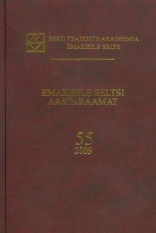ÖÖPÄEV JA AASTAAEG EESTI MURRETES
SEASONS AND TIMES OF DAY IN ESTONIAN DIALECTS
Author(s): Eva VelskerSubject(s): Morphology, Syntax, Sociolinguistics, Finno-Ugrian studies
Published by: Teaduste Akadeemia Kirjastus
Keywords: dialect studies; Estonian dialects; morphosyntax; lexicalization; time words:
Summary/Abstract: Time is an important factor defining events especially in narrative texts; among the 100 most frequent words in the Estonian Dialect Corpus, there are several words referring to time. The article discusses two groups of time words in Estonian dialects: words denoting time of day (päev ‘day’, öö ‘night’, hommik ‘morning’, õhtu ‘evening’) and seasons (kevad ‘spring’, suvi ‘summer’, sügis ‘fall’, talv ‘winter’). On the basis of data collected from the Estonian Dialect Corpus, the article explores the usage patterns of these time words and examines the expressions used to localize events in time, the grammatical marking (with locative cases) of these expressions, and dialectal differences therein. The time words in question were used in an adverbial function on 5441 occasions in the corpus, 3834 of which were as adverbs used to localize an event in time. There is considerable variation across dialects in the use of time-localizing expressions, but clear usage patterns appear. Some of these patterns are regional in nature: in peripheral dialects, especially the Coastal and Seto dialects, there is a stronger tendency to mark these expressions, local cases are used more often for this purpose. In addition, some single-word lexicalized time adverbs can be distinguished. The words with the strongest tendency to lexicalize are päev ‘day’ and öö ‘night’; one reason for this is their frequency of usage. Marking is also influenced by the relationship between meanings; while hommik ‘morning’ and õhtu ‘evening’ are used mostly in localizing expressions, this is not true of päev, and therefore the need for marking is greater, as the unmarked forms are also used to express duration. For the sake of clarity, the forms chosen to express timelocalizing meaning in the standard language are indeed the more strongly marked forms. In dialects, however, more weakly marked forms dominate. It has been pointed out that the low degree of marking is indicative of an aspiration toward economy; as such, the addition of a modifier reduces the need for explicit marking. A similar explanation can hold more generally as well: location in time does not require strong marking in certain types of texts, and the most typical meaning remains unmarked. For some words, the most typical meaning is simultaneous localization. The second important function is the expression of duration. The comparison with duration expressions may explain why some words are more clearly marked when used in a localizing meaning.
Journal: Emakeele Seltsi aastaraamat
- Issue Year: 2017
- Issue No: 63
- Page Range: 260-291
- Page Count: 32
- Language: Estonian

